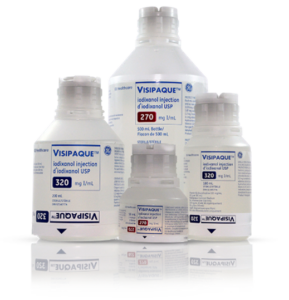Iodinated contrast agents have undergone significant evolution since the 1960s. In the ideal world, a contrast agent should have maximal efficacy (maximal attenuation of x-rays) and maximal safety (produce no adverse effects). In the real world, maximal safety means that a contrast agent should have minimal toxic or adverse effects on the body functions and preserve patient comfort. A champion of this challenge was the Swedish clinical radiologist Torsten Almén1.
As a practicing physician in the 1960s, Dr. Almén had become concerned about his patients’ pain when he injected the available high osmolar contrast media (HOCM). When swimming in the salty water off the west coast of Sweden his eyes would burn, yet swimming in the more brackish Baltic Sea, it was painless. Dr. Almen had a theory – the pain his patients felt was caused by the high osmolality of contrast media1.
Inspired, he hypothesized that the osmolality of iodinated contrast media was the main cause of their side effects. With a background in organic chemistry, Dr. Almén envisioned a way to reduce the osmolality of iodinated contrast media to produce a low osmolar contrast media (LOCM) and, ultimately, an iso-osmolar contrast media (IOCM) 1.
The osmolality of a contrast media is determined by the number of osmotically active particles present when a contrast agent is dissolved in solution. Osmolality is expressed in terms of the concentration of osmotically active particles(milliosmoles) per unit weight (kilograms) of water, or mOsm/kg H2O. The higher the ratio between the number of iodine atoms divided by the number of particles in a solution, the lower the osmolality2.
The basic form of an x-ray contrast media is an iodinated benzene ring (as seen in this illustration of diatrizoate below). Typically, 3 iodine atoms are delivered with each benzene ring of a contrast media. HOCMs, such as diatrizoate, are ionic, meaning they break up into two osmotically active particles (a negatively charged anion and a positively charged cation) in solution. Therefore, they deliver 3 iodine atoms for every 2 osmolar particles (3:2). This results in an agent with a high osmolality – up to 8 times greater than that of blood3.

By developing a non-ionic contrast media, Dr. Almén believed that the osmolality could be reduced significantly to approximately half that of HOCM. In solution, non-ionic agents do not break up into two osmotically active particles. This means they can deliver 3 iodine atoms for each osmolar particle (3:1). As this results in fewer molecules/kilogram of water than HOCM, the osmolality of a LOCM, such as iohexol, is reduced3.

A contrast molecule with only one benzene ring is called a monomer. By linking two non-ionic monomers together to form a dimer, more iodine can be delivered with less effect on osmolality. The synthesis of Visipaque (iodixanol), a non-ionic dimer, completed Dr. Almén’s visionary osmolality evolution for iodinated contrast media. Visipaque is iso-osmolar, meaning it has the same osmolality as blood at all concentrations. For each osmolar particle, Visipaque delivers 6 atoms of iodine (6:1) 3.

Iodinated contrast media has undergone significant changes since the development of the first-generation agents, HOCMs, in the 1950s. Much of this development can be attributed to the work of Dr. Torsten Almén, whose commitment to solving the pain his patients experienced with contrast media injection led to a great scientific advancement1.

Visipaque (iodixanol) is the only iso-osmolar agent available in Canada, and it represents the trend of iodinated contrast media towards improving patient comfort and tolerability without sacrificing image quality and clinical efficacy.
Visipaque is available in two concentrations.
- Visipaque 270 mg I/mL
- Visipaque 320 mg I/mL
Our medical team is available to help with the implementation of new protocols and procedures based on current guidelines and societal recommendations. GE HealthCare can provide product training as needed/requested. At GE HealthCare our intent is to partner with clinical sites to instill confidence in the usage of our products to positively impact patient outcomes.
Please scan the QR code below to see approved indications and Important Safety Information for Visipaque™ (iodixanol).

HOCM: High Osmolar Contrast Media
LOCM: Low Osmolar Contrast Media
IOCM: Iso-Osmolar Contrast Media
References:
- Nyman U et al. Acta Radiol 2016; 57(9): 1072-8.
- Speck U. In: X-Ray Contrast Media. Overview, use and pharmaceutical aspects. Springer, Berlin 2018.
- Jakobsen JA. Eur J Radiol 2007; 62(Suppl.): s14-25.
© 2024 GE HealthCare
GE is a trademark of General Electric Company used under trademark license.
June 2024 JB01135CA

